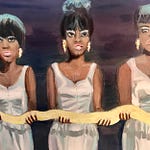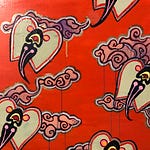This piece was written when OWS was actually occupying Wall Street.
"People should not be afraid of their governments. Government should be afraid of their people." — Alan Moore
Weeks ago, I saw a photo on the internet that really stuck in my gag reflex: A piggy-faced group of Wall Street insiders -- men in pinstripe suits and ties, women in silk dresses and big ass, fuck-you, 11mm Barbara Bush pearls -- were sitting on balcony overlooking Zucotti Park, smugly looking down on the protestors, drinking champagne.
Two thoughts occurred to me:
1. This is exactly why God rots tomatoes.
and
2. Dressing for class warfare can be a tricky endeavor, but it is verr-r-ry important.
Just as the OCCUPY movement is struggling to articulate a specific, coherent paradigm (it being no easy task to represent the frustrations of 99% of 7 billion people on one bumpersticker) -- a coherent OCCUPY fashion statement also has yet to emerge.
Historically speaking, it is de rigueur for a complicit mainstream press to undermine protest movements by waggling their fingers at particularly hazardous examples of counterculture fashion. The Zoot Suit became symbolic of the "undesirable element" during World War II-- the flashy, extravagant style by which black and Hispanic youths distanced themselves from the status quo was framed by the media as being "unpatriotic." "Dirty long-haired hippies" became the way the establishment besmirched the character of Vietnam protestors of the 1960's. Today, if you're a topless, pink-haired lesbian protesting in a tutu or a white kid with dreadlocks, a tattooed neck and earlobes you can stick a fist through, the elderly Viewers at Home in Omaha watching FOX are likely to regard OCCUPY protestors as The End of the World As They Liked It. Fashions tend to be tribal, and even a batch of protestors as diversified as OWS is going to be visually reduced, in media images, to its most radicalized and potentially off-putting representatives.
"In the Battle of Ideas, Aesthetics Matter," is the slogan of "Suits for Wall Street," a group that has been campaigning to provide suits to OWS protestors. "Suits are camouflage in the warrens of Wall Street," says their literature. "Need a bathroom? Wear a suit...Want to walk past a police barricade?....Try wearing a suit...In the 1960s you could fly your freak flag high. In 2011, it just looks sloppy."
Adopting the markings of the power elite is no mere sartorial prank-- it is a strategy supported by significant precedents in US protest history.
Before 9/11, the biggest workplace tragedy every to hit Manhattan was in 1911, at the Triangle Shirtwaist Factory. When a fire broke out, one hundred and forty-five garment workers -- most young immigrant girls -- were trapped on the upper floors because the management had locked the doors to prevent the girls from taking unauthorized breaks. Seamstresses perished in flames or jumped to their deaths, and New York was forced to acknowledge the horrific working conditions in its sweatshops.
Demonstrations by immigrants and the lower-class were relatively easy to suppress in those days: Industrial strikers were usually beaten, jailed, and shot. But “The Mink Brigade,” a group of upper-class women, decided to join the picket lines. Mink proved to be highly effective armor for that battle -- the cops knew it would be a PR disaster to shoot Alva Vanderbilt Belmont and other uptown society ladies in fur coats -- and so, the garment workers' labor movement became legitimized.
Dr. Montgomery McFate, a Yale cultural anthropologist, suggests OWS protestors may be hurting themselves by NOT wearing suits. "The 1% only listens to the 1%," she told me, via phone interview. Due to their radical clothing, counter-culture protestors may be "structurally disempowering themselves from being heard by the people who have the power to make the policy changes that they are demanding."
Protestors in suits, she adds, could change the game by calling into question the semiotics of suit wearing. "At worst it could be taken as jest....at best it could be taken as chance to bridge the gap (between the 1% and the 99%). "
There are a variety of recommended "protest-sessories" for any demonstration:
Comfy shoes are always recommended (I personally favor steel-toed boots, in case of bottleneck scrum-situations where your feet get stepped on.)
It doesn't hurt to carry a bottle of Maalox diluted with water, which can be used as an eyewash in the event of pepper-spray. A flyer circulated by Egyptian protestors recommended carrying pot-lids, which may be used as a shield against rubber bullets and batons (pot lids are also effective noisemakers, if one wishes to engage in a clanging form of popular protest in known in Spanish-speaking countries as cacerolazo.) A can of spray paint (if you can control your urge to vandalize) may also be used to obscure the vision of advancing riot police.
Militants, however, are incredibly sexy -- and an embrace of properly sexy militant apparel can sell a revolution just like any great ad campaign.
Tom Wolfe coined the term "radical chic" in 1970 to poke fun at celebrities and other members of high society who were seduced into supporting revolutionary causes because of their innate sex-appeal. Wolfe used Leonard Bernstein as his most risible example after Bernstein threw a fundraiser in his home for the Black Panther Party (a movement which in most cases was explicitly opposed to white elites like Leonard Bernstein.)
There are strong protest fashion statements that have proven to be particularly effective weapons of cultural warfare:
#1. The Beret: For some reason, if you wanna be a militant leftist icon, it's all about the beret -- it's the little black dress of revolutionary socialism. All the most comely and iconic spokesmodels for the global class struggle cocked one: the Black Panthers, Patty "Tanya" Hearst in her brainwashed-by-the-SLA-prime, Carlos the Jackal, Faye Dunaway in Bonnie & Clyde, and of course, Che Guevara, now the Hello Kitty of the international socialist revolution.
#2 The Hoodie: The hooded sweatshirt which is currently the garment of choice for anarchists was first produced in the 1930's, for New York laborers working in frozen warehouses. Today, the hoodie remains symbolic of the cultural paradigm shift inspired by Hip-Hop - and has taken on a menacing semiotic power of its own. Not for nothing was the hoodie banned in various shopping centers of the UK, Australia and New Zealand...or, for that matter, was it the outerwear of choice for both Banksy and the Unabomber.
#3 Sunglasses (or paint goggles): A common rule is to never wear contact lenses to an occupation - getting tear gas on them apparently su-u-u-u-ucks. Eyewear is not only a decent identity concealer and protection against chemical deterrents, but it also enables a discriminating revolutionary to be cool like Fonzie.
#4 The Bandanna/ The Keffiyeh
Whether you're a Blood, a Crip, a graffiti artist or just having your own little intifada, a cotton scarf provides a reasonable amount of bandito-style anonymity, protects against pepper spray and tear gas...and can be used as both a blanket and a napkin during long nights of group pizza consumption.
#5 The Guy Fawkes Mask:
Guy Fawkes was a radical 17th century Englishman who is remembered for failing to blow up the House of Lords with the infamous "Gunpowder Plot." The Guy Fawkes mask was popularized shortly after the release of the 2006 film “V for Vendetta” (an anti-totalitarian tale based on the comic book by Alan Moore) when the Anonymous group wore the mask during demonstrations against the Church of Scientology. Numerous Guy Fawkses have since been turning up at various OCCUPY locales, replete with both the anonymity and the solid punch of social history that the mask provides.
#6 The Ski Mask and/ or The Balaclava
Easily the scariest and most anonymizing of all headwear, the knit ski-mask is not only an excellent source of warmth, but has been used as an intimidating sartorial weapon since the Crimean war. It's a daring look, but one that has been successfully rocked by the Irish Republican Army and several incarnations of Zapatista leader Subcommandante Marcos.
In short, any effective class war contains a style war which needs to be acknowledged and prosecuted. The energy a protestor uses to get dressed in the morning can substantially strengthen or undermine the cause. History has proven that if you wage an effective aesthetic propaganda campaign, even if you don't succeed in changing the world for the better, at least you'll get invited to the right dinner parties.
Artwork: “Gainesburger,” oil on canvas by Cintra Wilson, 2019
cintraw@gmail.com














Share this post